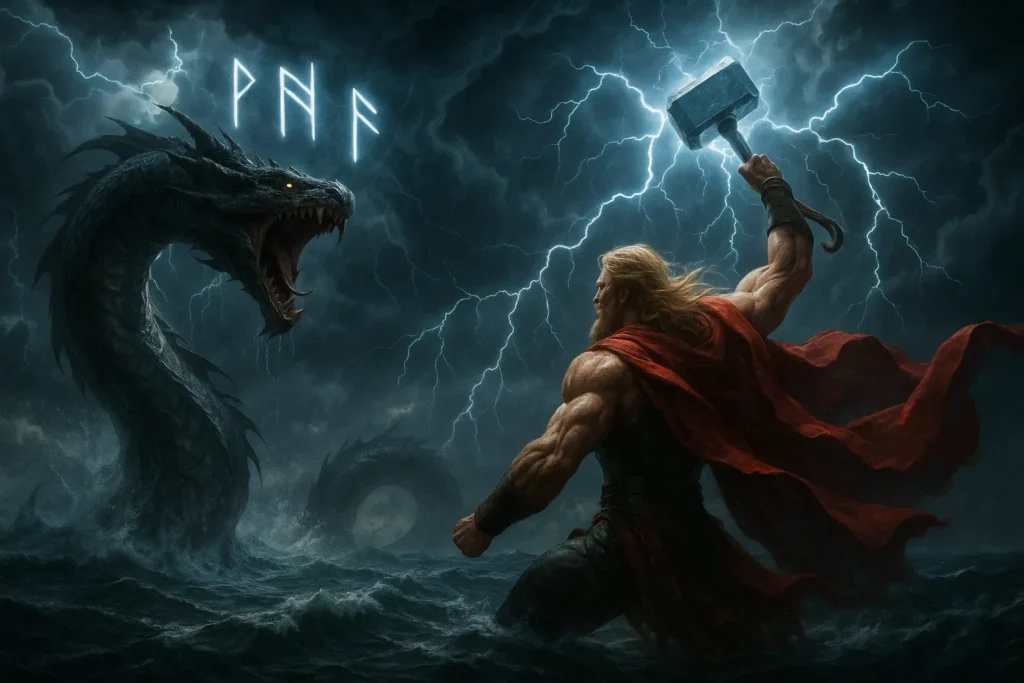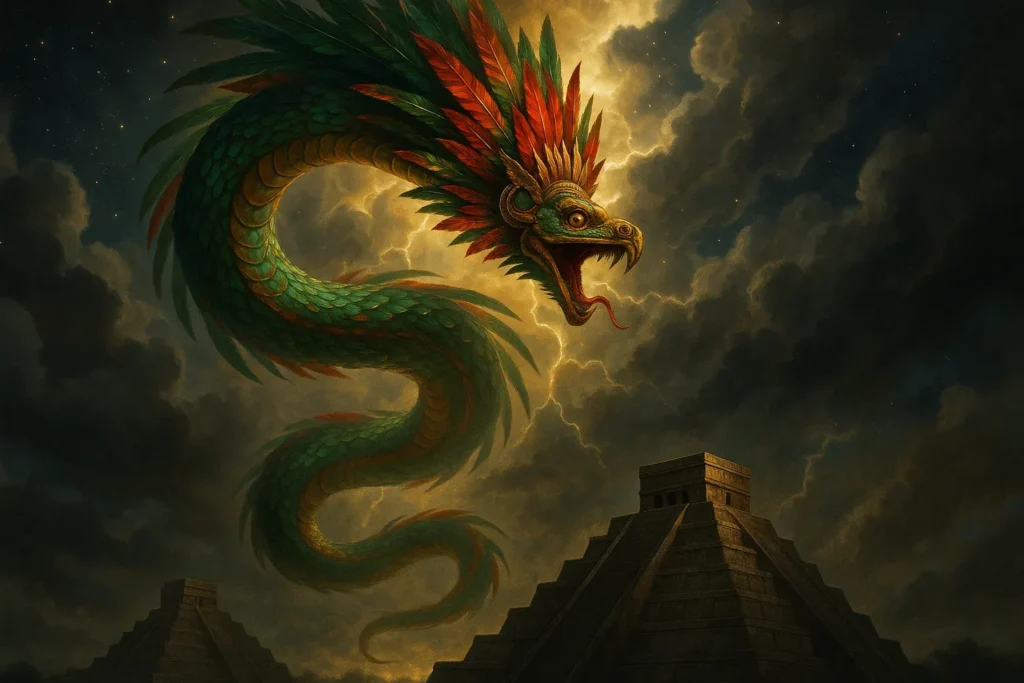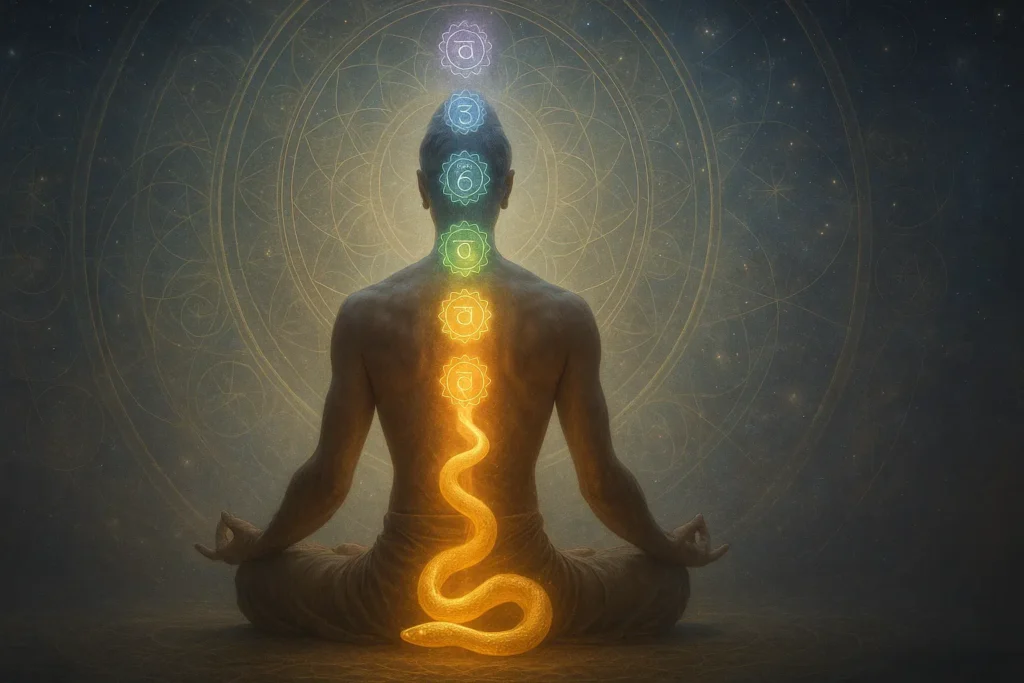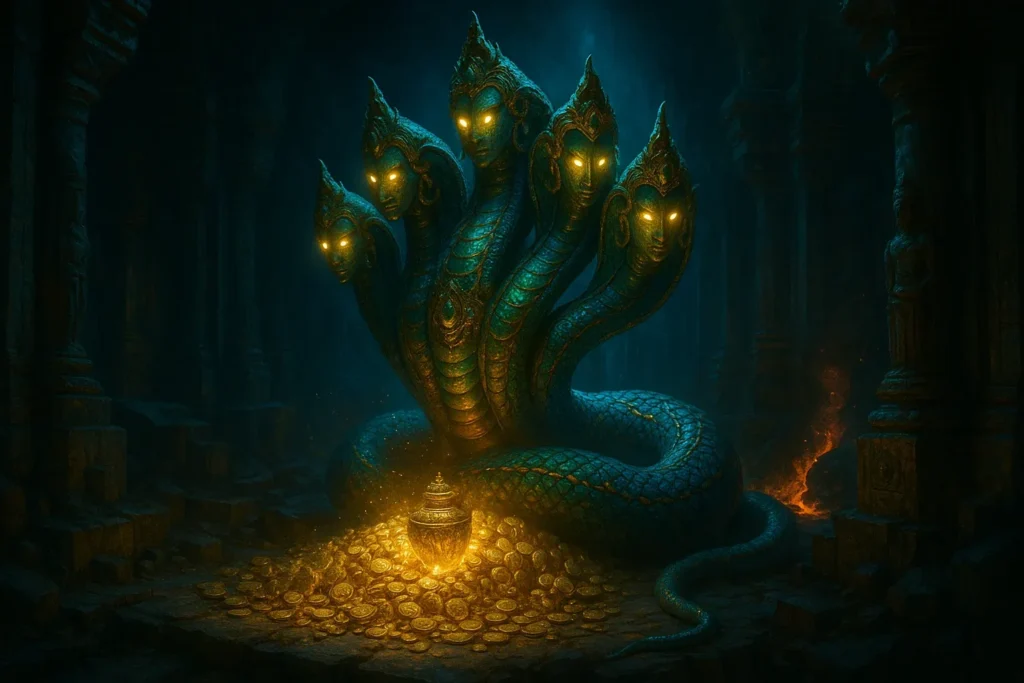Serpent lore in mythology reveals how cultures across the world transformed humanity’s deepest fears into sacred symbolism. Serpents slither through nearly every mythology as powerful symbols of both fear and fascination. In many legends, they are chaos incarnate—colossal dragons to be vanquished by heroes—yet elsewhere they guard divine treasures or secrets of immortality. From India’s sacred Nagas to the Norse World Serpent, cultures worldwide turned humanity’s primordial fear of snakes into epic narratives of cosmic struggle and balance. .
We find serpents at the beginning of creation myths, coiled around the world or beneath it, and at the edges of the world in apocalypse tales. Whether as monstrous dragons to be slain or mystical serpents whose coils support the cosmos, these creatures embody the thin line between chaos and order that ancient peoples sensed in nature.
Nagas of Hindu Myth: Cosmic Serpents and Divine Churners
Hindu lore is rich with naga serpents – some benevolent, some fearsome – who play cosmic roles. Shesha (also called Ananta, the Endless) is the majestic king of the nagas and a primordial being. It is said that Shesha’s innumerable mighty cobra hoods uphold the entire universe, carrying all planets upon them while he sings the glories of Lord Vishnu.
Vishnu himself is often depicted reclining serenely on Shesha’s coils in the cosmic ocean, with the serpent’s thousand heads forming a canopy over the sleeping god. Lakshmi, the goddess of fortune and Vishnu’s consort, sits at his feet; in this peaceful tableau, the immense serpent embodies stability and cosmic order (as shown below).

Vishnu rests on the coils of the endless serpent Shesha in the cosmic Ocean of Milk, while Lakshmi massages his feet. In Hindu cosmology, the naga Shesha (also called Ananta, meaning “Endless”) supports the world on his hoods and remains unshaken even when creation cycles dissolve, symbolizing eternal cosmic order.
Not all serpents in Hindu myth are peaceful – many are participants in dramatic divine events. Vasuki, for example, is a great naga king who became a literal rope in one of Hinduism’s grandest tales. In the legend of Samudra Manthan (the Churning of the Ocean), gods and demons worked together to churn the ocean of milk to produce amrita, the nectar of immortality. They wrapped the serpent Vasuki around a mountain as the churning rope.
With gods pulling from one end and demons from the other, Vasuki allowed himself to be used in this cosmic tug-of-war. The strain made him vomit deadly poison, which darkened his hood – yet that poison (Halahala) was heroically swallowed by Shiva to save the world. Vasuki’s sacrifice was pivotal to retrieving the nectar of life, underscoring how even a terrifying serpent could serve a divine purpose in maintaining cosmic balance.
Hindu mythology also abounds with fierce serpent-demons that embody chaos – and the heroes who defeat them. The Rigveda speaks of Vritra, a colossal dragon or serpent asura who brought drought by hoarding all the world’s waters. Vritra is described as a “human-like serpent” blocking the rivers, until the storm-god Indra faced him in battle.
Armed with a thunderbolt forged by the gods, Indra struck Vritra and split him open, releasing the life-giving waters to flow freely again. By slaying this drought-serpent – sometimes called Ahi (snake) – Indra earned the epithet Vṛtrahan (“Slayer of Vritra”) and restored order from chaos.
This Vedic victory of the thunder god over the water-hoarding serpent became a prototype for many dragon-slaying myths to come. In later Hindu lore, echoes of this theme persist – from Kāliya, the multi-headed naga subdued by young Krishna dancing on its heads, to Mahishasura (a buffalo-demon with serpentine qualities) defeated by Goddess Durga.
The nagas thus span a spectrum in Indian myth: at one extreme, cosmic protectors like Shesha and Vasuki who uphold or assist creation, and at the other, chaos serpents like Vritra whose defeat releases life’s sustenance. Both sides of the serpent symbolize the delicate balance between creation and destruction.
Notable Serpents in Hindu Lore
- Shesha (Ananta) – The king of the Nagas, depicted as a gigantic serpent with endless coils. Shesha holds the universe on his hoods and serves as Lord Vishnu’s couch, symbolizing the foundation of the cosmos. His name means “Remainder,” as he remains even after each cycle of creation ends.
- Vasuki – A nagaraja (serpent king) famed for his role in the Samudra Manthan. The gods and demons wrapped Vasuki around Mount Mandara as the churning rope to extract the nectar of immortality. Though stretched and poisoned in the process, Vasuki’s cooperation was crucial in obtaining the amrita.
Vritra – A fearsome dragon/serpent asura personifying drought. He blocked the rivers and kept waters captive until Indra, king of the gods, slew him with a thunderbolt, thus releasing the waters and restoring cosmic order. In Vedic hymns, Vritra is also called Ahi (snake) and his defeat by Indra is a central myth of chaos overcome by divine force.
The World-Encircling Serpent of Norse Myth

Across the world in Norse mythology, we find a serpent just as colossal as Shesha, but far more malevolent in nature – Jörmungandr, the Midgard Serpent. According to the Norse Eddas, Jörmungandr is one of Loki’s monstrous offspring, cast into the great ocean by Odin. There the serpent grew until it could encircle Midgard (the human world) entirely, biting its own tail.
In this way Jörmungandr became a living ouroboros – the snake forming a circle around the world. The Vikings called it the World Serpent, imagining that every ocean was actually the coils of this unfathomably large snake. Only when Jörmungandr finally releases its tail will the end of the world (Ragnarök) begin.
The Norse saw the World Serpent as an embodiment of the dark, chaotic ocean that edges civilization – a threat kept barely in check by its self-contained circle. Fittingly, Jörmungandr’s arch-enemy was Thor, the thunder god and protector of Midgard. Thor and this serpent have a long history: in one myth Thor nearly fishes Jörmungandr from the sea while on a giant’s boat, and in another he tries to lift a huge cat which is secretly Jörmungandr in disguise.
Their final confrontation comes at Ragnarök, the Norse apocalypse. As the prophecy foretells, when the end times arrive the World Serpent uncoils and rises from the sea, poisoning the sky. Thor meets Jörmungandr in a ferocious duel and manages to slay the great snake – but staggers back nine steps before succumbing to the serpent’s deadly venom.
The image of the fearless thunder god and the gigantic sea-serpent destroying one another is one of the most dramatic in Norse legend. It also resonates with the Vedic tale of Indra and Vritra: in both, a storm deity battles a world-threatening serpent, and the defeat of the serpent is necessary for cosmic order (the return of rain or the survival of the world).
Scholars have noted that functionally Vritra and Jörmungandr serve a similar mythic role, despite arising in cultures far apart – perhaps reflecting an ancient Indo-European motif of the thunderer versus the dragon of chaos.
Thor’s final battle with the Midgard Serpent. In Norse myth, Jörmungandr encircles the world, biting its own tail as an ouroboros until the day of Ragnarök. When that doom arrives, the serpent uncoils to fight Thor, and the thunder-god slays the beast at the cost of his own life. This echoes other Indo-European legends of a storm-god vanquishing a giant snake – for instance, the Vedic god Indra killing the dragon Vritra to release the captive waters.
Norse mythology contains other serpentine creatures too. In the roots of the World Tree (Yggdrasil) crawls Níðhöggr, a dragon that gnaws at the tree’s foundations – another embodiment of destructive chaos lurking at the base of the orderly cosmos. There are also dragons in hero sagas (Fafnir, for example, slain by Sigurd), but these are often more like treasure-hoarding dragons than world-ending cosmic serpents. The World Serpent Jörmungandr remains the most iconic snake of Norse lore, literally surrounding the world and heralding its doom.
Through it, the Norse imagined that the very ocean was a dragon holding reality together until the final cataclysm. When Thor’s hammer met Jörmungandr’s jaws, it was more than a battle of god and monster – it was a collision of cosmic forces, with order and chaos each destroying the other to reset the world’s cycle.
Dragon-Slayers of Greek Myth: Python and the Hydra

The Greeks, too, filled their mythic landscapes with serpentine foes. In fact, one of the first deeds of the Olympian gods was a serpent-slaying: the god Apollo fought the mighty snake Python to claim his shrine at Delphi. According to myth, Python was a colossal serpent-dragon born of Gaia (Earth) that guarded the sacred oracle of Delphi in the days before the Olympians.
When Apollo was born, he sought to establish his own oracle there, but first had to eliminate Python, who refused to yield the holy site. Apollo, only a few days old, chased the serpent and shot it dead with his arrows, taking over Delphi as his own sanctuary. By slaying Python and absorbing its power of prophecy, Apollo became the new divine oracle.
However, this deed was considered so momentous (and perhaps impious) that Apollo had to undergo purification and institute the Pythian Games to atone for killing the ancient guardian. The dragon Python’s death thus marked the transition from an older order (Gaia’s chthonic powers) to a new one led by the Olympian gods.
Yet even as a vanquished foe, the memory of Python lived on in the title of Apollo’s priestess – the Pythia – and in the myths that cast Apollo as a dragon-slayer bringing enlightenment to a formerly dark place.
If Apollo’s Python was a guardian turned adversary, the Lernaean Hydra was pure monster from the start. The Hydra was a multi-headed water-serpent born to the monsters Typhon and Echidna, and it terrorized the marshes of Lerna in Greece. As one of his famous Twelve Labors, the hero Heracles (Hercules) was sent to destroy this venomous beast.
But killing the Hydra was no simple task – whenever Heracles lopped off one of its heads, two more would sprout in its place, a seemingly hopeless battle. Realizing brute force alone wouldn’t suffice, Heracles enlisted the help of his nephew Iolaus.
Each time Heracles cut off a head, Iolaus swiftly cauterized the stump with a flaming torch, preventing regrowth. In this way they systematically slew the Hydra’s many heads and finally the immortal central head, which Heracles buried under a heavy rock.
The Hydra’s poisonous blood was so potent that Heracles later used it to tip his arrows – a deadly advantage that would ironically lead to his own doom (when his wife unwittingly gave him a tunic smeared with the Hydra’s blood, it fatally burned him).
The phrase “cutting off a hydra’s head” became a Greek metaphor for tackling a problem that only multiplies as you fight it. In a broader sense, the Hydra represents the chaos of the swamp – a seething, regenerative menace – and Heracles’ victory shows how wit and courage can overcome ever-reproducing evils.
Greek mythology has no shortage of serpentine or dragon-like creatures beyond these two. Zeus himself faced the monstrous Typhon, a giant whose lower half was a tangle of viper coils, in a battle for supremacy – though Typhon is often classed more as a giant than a mere serpent.
There was also Ladon, the dragon who coiled around the tree of golden apples in the Garden of the Hesperides, defeated by Heracles as well. But Python and Hydra stand out for their iconic roles: one as a vanquished guardian that gave Apollo his glory, the other as an ever-regenerating monster that nearly overwhelmed Heracles.
Unlike India’s nagas, Greek serpent-monsters are rarely wise or benevolent; they are usually obstacles to be overcome by culture heroes or gods. Yet even in defeat, they often confer something to the victor – a prophetic power, a potent weapon, or eternal fame. In this way, the Greeks acknowledged that the dragon’s power could be co-opted even as the beast was slain, much as Apollo took Python’s oracle for his own, and Heracles turned the Hydra’s venom into his weapon.
Apophis: The Chaos Serpent of Egypt
No survey of world serpent lore is complete without Apophis (also known as Apep), the great chaos-snake of ancient Egyptian mythology. While many cultures pushed their giant serpents to the mythic fringes, the Egyptians made theirs a nightly cosmic threat. Apophis was envisioned as a gargantuan serpent lurking just below the horizon, in the dark waters of the underworld.
Every single night, as the sun god Ra traveled through the underworld on his solar boat, the serpent Apophis would attack, striving to devour the sun or halt its passage. The Egyptians described Apophis with vivid epithets: “the Evil Dragon,” “Serpent from the Nile,” and “Lord of Chaos.” At times they said he stretched over 16 yards long with a head of flint – a seemingly unstoppable force of primordial disorder.
Yet Apophis was fated to lose, again and again. Each night, Ra and his defenders – which included other gods like Set and the protective serpent Mehen – battled Apophis to ensure the sun would rise at dawn. In many depictions, Apophis is shown being pierced by spears or sliced by knives wielded by the gods on Ra’s boat.
According to the Book of the Dead and other Egyptian texts, the world’s survival depended on these nocturnal victories: if Apophis ever triumphed, the sun would fail to rise and creation would collapse into chaos. Egyptian priests even conducted rituals to aid Ra in this eternal fight – they crafted wax effigies of Apophis and recited spells to curse and destroy the serpent each night.
This daily combat symbolizes the Egyptian concept of maat (cosmic order) versus isfet (chaos). Apophis, as the embodiment of isfet, could never be permanently killed – chaos can never be utterly eliminated – but he could be subdued each day to allow the sun to be reborn come morning.
Ironically, some Egyptian myths say Apophis himself was born from Ra’s umbilical cord or from the spit of the goddess Neith – meaning the chaos serpent was a byproduct of creation itself, destined to challenge its order. In the end, Apophis was not a dragon to be slain once and for all (unlike Vritra or Python); he was an ever-repeating adversary, as cyclical as nightfall.
His endless writhing in the underworld echoed the unpredictable flood of the Nile or the blinding rage of storms – forces that could bring destruction if not tamed. The daily victory of Ra over Apophis gave the Egyptians a powerful image of hope: no matter how dark the night, the dawn will come as long as the champions of order do their duty.
The serpent of chaos will be bound and sliced apart, and the sun will emerge victorious, lighting the world anew. It is a cosmic drama that played out in every sunrise, making Apophis perhaps the most existentially important serpent in world mythology – not a one-time enemy, but an eternal one whose defeat underpins the very continuation of life.
Serpent Symbolism: Guardians of Wisdom and Eternal Renewal
Beyond the battles and cosmic showdowns, serpents often take on a more mystical role in world mythology – as symbols of wisdom, immortality, and the cyclic nature of the cosmos. In Hindu and Buddhist traditions, nagas are not only monsters but also wise beings who guard treasure troves and esoteric knowledge.
For example, in Buddhism it is said that a naga king protected the Buddha and later presented him with the Prajnaparamita sutras (teachings on perfection of wisdom). The Sanskrit word naga itself became synonymous with a wise or enlightened being in some contexts.
This duality – serpent as feared enemy and serpent as guardian – speaks to humanity’s ambivalent relationship with these creatures. On one hand, snakes can be deadly; on the other, their ability to shed skin made people associate them with rejuvenation and immortality.

One of the most profound serpent symbols is the kundalini serpent of Indian yogic mysticism. Kundalini is envisioned as a coiled serpent energy sleeping at the base of the human spine. When awakened through yoga or meditation, this serpent energy uncoils and ascends through the chakras, bringing spiritual illumination.
An early text, the Yogakundali Upanishad, vividly describes Kundalini: “The divine power, Kundalini, shines like the stem of a young lotus; like a snake, coiled upon herself she holds her tail in her mouth and lies resting half asleep at the base of the body.”. This image – a serpent holding its tail in its mouth – directly evokes the ouroboros, the ancient symbol of a snake biting its own tail. Indeed, esoteric Hindu teachings explicitly connect Kundalini to the ouroboros motif.
As the serpent ascends and reunites with the divine (often visualized as the union of the serpent goddess Shakti with Lord Shiva), it completes a circle – much like the tail-devouring snake – symbolizing the cycle of samsara (birth and rebirth) being transcended into oneness.
In the words of one modern commentator, when Shakti (the divine feminine) is separated from Shiva she is “the endless Ouroboros, the dragon biting its own tail, symbolizing the cycle of samsara”. Here the serpent is not a foe to be defeated but the very path to enlightenment: one must ride the serpent power upward, so to speak, to achieve spiritual liberation.
The Ouroboros as a symbol has appeared in many cultures – from ancient Egypt to Greece, and in Norse iconography as we saw with Jörmungandr. It is among the oldest mystical symbols of humanity. The ouroboros (Greek for “tail-eater”) depicts a snake (or dragon) forming a perfect circle by swallowing its own tail.
This striking image was interpreted as early as the Hellenistic period as signifying eternal cyclic renewal – an infinite cycle of death and rebirth, of endings that lead to new beginnings. Alchemists in late antiquity and medieval times were fascinated by the ouroboros, seeing it as embodying the motto “All is One” – the unity of opposites, the circular nature of the philosopher’s stone process.
But the symbol’s roots go deeper: the earliest known ouroboros appears in the tomb of Tutankhamun in Egypt, where twin serpents coil around to encircle a depiction of the unified Ra-Osiris, representing the beginning and end of time. To the Egyptians, a snake devouring its tail represented the cyclical nature of the year and the eternal return of time.
The Norse, as noted, gave this concept a fearsome twist in Jörmungandr – the ouroboros became a world-encircling monster whose breaking of the circle would spell doom. In contrast, Indian yogic thought internalized the ouroboros as the Kundalini serpent completing the circle of spiritual fulfillment.
Whether as symbol or story, the serpent always seems to circle back to the same fundamental themes. Its limbless, slithering form and deadly bite made it an emblem of chaos, death, or evil in many stories – hence dragons to slay, snakes to charm. Yet its ability to shed its skin and emerge “reborn” made it equally a token of healing, renewal, and immortality (consider the snake coiled around the rod of Asclepius as the emblem of medicine).
We see cultures turn snake fear into snake worship: the nagas are prayed to for rain and prosperity, the cobra is garlanded in Shiva temples, and snakes were often kept in sacred precincts as divine guardians. In Mesoamerican lore, a feathered serpent (Quetzalcoatl) was revered as a wise founding deity. In China, dragons (often conceived as serpent-like) were symbols of imperial authority and beneficent power over rain and water. Thus, the serpent can signify wisdom and life just as much as chaos and death. It is the paradox of the human attitude toward nature’s most enigmatic reptile.
From Chaos to Cosmos: The Enduring Allure of Serpent Myths
Why do serpent tales endure from age to age? Perhaps because they tap into something raw and profound in the human psyche. Snakes were among the earliest dangers our ancestors knew – quick, silent, and sometimes lethal. In our collective imagination, that fear transformed into epic dragons and sea-serpents whose defeat became a metaphor for overcoming any formidable obstacle.
At the same time, snakes also fascinated us with their elegance and seeming immortality, inspiring myths of cosmic serpents holding up the heavens or encircling the world. The repetitive motif of a hero (often a thunder or sun deity) battling a giant serpent reflects our eternal hope that order can triumph over chaos – that the sun will rise after the darkest night, that floods will recede and nourish the land once more.
Indra shatters the dragon to release the waters; Thor’s hammer brings down the World Serpent to herald a new world; Ra’s light emerges victorious each dawn over the snake of darkness. In each case, the message is the same: without these battles, life as we know it would be lost, but through courage and divine aid, balance is restored.
Yet, as the ouroboros teaches, every ending is a new beginning. The slain serpent often bequeaths something precious – rain for a parched earth, wisdom for a new god, strength for a hero, or simply a reminder of the cycle of life. The snake eating its tail tells us that creation and destruction are intertwined, each feeding the other.
This could be why many cultures did not truly hate serpents, even when they feared them. Instead, they honored them in rituals, built serpent shrines, and incorporated them into their most sacred art. The recurring presence of serpents in mythology – whether as Nagas, dragons, hydras, or world-encircling oroboros – shows how deeply this symbol resonated.
It is as if humanity collectively decided that the snake, of all creatures, best represents the mystery of the unknown: it dwells in dark places, moves in ways other animals do not, and can bring both sudden death and miraculous healing.
In the end, serpent lore remains “evergreen” because it speaks to fundamental human concerns. The fear of the dangerous other (the venomous beast), the need for heroes and divine protectors, the quest for wisdom and eternal life, and the observation of nature’s cycles – all these themes coil around the figure of the serpent.
We are as captivated by these stories today as ancient listeners were millennia ago, because on some level we are still watching the skies for dragons and dreaming of hidden knowledge guarded by serpents. From the rich mythologies of India with their cosmic naga kings, to the sagas of Europe where knights battle wyrms, to the rock art of indigenous Australia depicting the Rainbow Serpent – the lore of the serpent connects the world in a shared narrative.
It reminds us that chaos is always lurking and must be confronted, but also that within chaos lies the seed of wisdom and renewal. Like the ouroboros encircling the world, the serpent will forever hold a circular grip on our imagination, ensuring that these legendary narratives of heroes, monsters, and cosmic balance continue to be told and transformed for generations to come.
Sources:
Serpents in Hindu mythology and scripturesen.wikipedia.orgen.wikipedia.org en.wikipedia.orgen.wikipedia.org;
Norse accounts of Jörmungandr and Ragnarök
Greek myths of Apollo and Python, Heracles and Hydra en.wikipedia.orgen.wikipedia.org;
Egyptian texts on Apophis and Ra’s daily battle en.wikipedia.orgen.wikipedia.org;
Kundalini and ouroboros symbolism in yogic and alchemical tradition mythsterhood.commythsterhood.comen.wikipedia.org.
Each culture’s serpent lore, while unique in detail, reflects a common motif of the snake as a potent symbol of chaos to be overcome and a paradoxical source of wisdom and renewal for the world.

